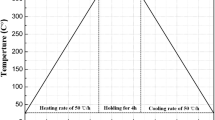Abstract
Reactive materials are a new class of energetic materials that extremely and efficiently release energy under the influence of high impact loading. An impact tester is used in the present study to explore the impact ignition characteristics of Al/PTFE reactive materials and the impact ignition pressure of Al/PTFE reaction materials under different conditions. The experimental result shows that the critical ignition pressure is approximately 1.44 GPa. Meanwhile, it also shows that the material compactness has a much less pronounced effect on the impact ignition pressure for this reactive material if the loading time scales are of the order of several milliseconds. Plastic work and viscous heat both play a significant role in impact ignition. Finally, it is shown that impact ignition ensures a higher energy release rate than surface ignition.
Similar content being viewed by others
References
N. N. Thadhani, “Shock-Induced and Shock-Assisted Solid-State Chemical Reactions in Powder Mixtures,” J. Appl. Phys. 78 (4), 2129–2138 (1994).
R. G. Ames, “Vented Chamber Calorimetry for Impact- Initiated Energetic Materials,” in 43rd AIAA Aerospace Sciences Meeting and Exhibition (2005), p. 279.
E. B. Herbold, “Particle Size Effect on Strength, Failure, and Shock Behavior in Polytetrafluoroethylene–Al–W Granular Composite Materials,” J. Appl. Phys. 104 (10), 103903 (2008).
S. Q. Yang, S. L. Xu, and T. Zhang, “Preparation and Performance of PTEF/Al Reactive Materials,” J. Nat. Univ. Defense Technol. 30 (6), 512–516 (2008).
R. G. Ames, “Energy Release Characteristics of Impact- Initiated Energy Materials,” Mater. Res. Soc. 896, 123–132 (2006).
H. F. Wang, Y. F. Zheng, Q. B. Yu, Z. W. Liu, and W. M. Yu, “Impact-Induced Initiation and Energy Release Behavior of Reactive Materials,” J. Appl. Phys. 110 (7), 074904 (2011).
R. G. Ames, “Reaction Efficiencies for Impact-Initiated Energetic Materials,” in 32nd Int. Pyrotechnics Seminar (2005).
X. F. Zhang, A. S. Shi, L. Qiao, J. Zhang, Y. G. Zhang, and Z. W. Guan “Experimental Study on Impact- Initiated Characters of Multifunctional Energetic Structural Materials,” J. Appl. Phys. 113 (8), 083508 (2013).
I. Song and N. N. Thadhani, “Shock-Induced Chemical Reactions and Synthesis of Nickel Aluminides,” in Symp. on Reaction Synthesis of Materials23A, 41–48 (1992).
X. F. Zhang, A. S. Shi, J. Zhang, L. Qiao, Y. He, and Z. W. Guan, “Thermochemical Modeling of Temperature Controlled Shock-Induced Chemical Reactions in Multifunctional Energetic Structural Materials under Shock Compression,” J. Appl. Phys. 111 (12), 123501 (2012).
J. Borrelli, “The Effects of Fuel Particles Size on the Reaction of Al/TEFLON Mixtures,” Masters’ Thesis (Texas Tech. Univ., 2006).
Author information
Authors and Affiliations
Corresponding author
Additional information
Original Russian Text © M.H. Zhang, W.J. Ruan, K. Dong, Y.G. Yu.
Published in Fizika Goreniya i Vzryva, Vol. 53, No. 3, pp. 110–114, May–June, 2017.
Rights and permissions
About this article
Cite this article
Zhang, M.H., Ruan, W.J., Dong, K. et al. Experimental investigation on impact ignition of Al/PTFE reactive materials. Combust Explos Shock Waves 53, 344–348 (2017). https://doi.org/10.1134/S0010508217030121
Received:
Published:
Issue Date:
DOI: https://doi.org/10.1134/S0010508217030121




